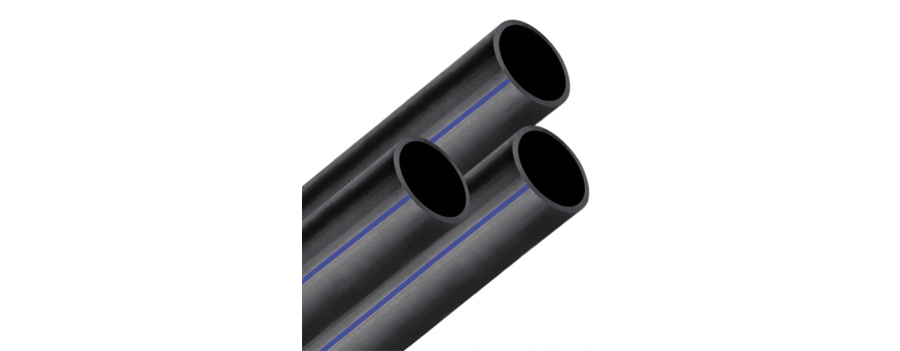GENERAL FEATURES
Polyethylene pipes are obtained from the raw material obtained after the polymerization process of ethylene gas obtained from petroleum. The number Pe 100 indicates 10.0MPa, which is the environmental stress (σ) value of the product. This value started from 32 and studies on Pe 125 continue. Since the increase of this value indicates that the strength increases, it means that the wall thickness becomes thinner for the same pressure class. This means that the inner diameter of the Pe 100 pipe increases with the saving of raw material. Improvements in these values increase its market share as it offers cost advantage over alternative products.
It is a recyclable product as it is included in the polyethylene thermoplastic product group. Considering the event in terms of environment, it can be used in second class products when collected again.
Since the welding ability of the polyethylene product is very high, the joining methods are varied. Joining methods; butt welding method, electrofusion welding method, push-socket method and extrusion welding method.
Polyethylene is not corroded, not affected by chemicals, and has high abrasion resistance, making it an advantage over alternative products. It offers a minimum service life of 50 years. Networks can suddenly become out of use due to earthquakes. Earthquakes have shown that while polyethylene pipes can be used during earthquakes, rigid pipes are completely disabled and new lines are installed.
In places where erosion is experienced, Pe 100 absorbs opening by elongation as a result of the 600% elongation capability of the pipe. It solved the problem in lines that had to be changed frequently in landslide areas.
The fact that it can be produced at different pressures in accordance with the project has been effective in the feasibility of the projects as it saves raw materials.
Polyethylene pipes (Pe100 and HDPE) are most commonly used in Scandinavian countries. The most important reason for this is that it preserves its elastic properties up to -40 ° C and is not affected by water turning into ice. While all steel pipes are split with ice, Polyethylene expands and absorbs the increase in volume. With the ease of rivers, lakes and sea passes with polyethylene pipes (Pe100 and HDPE), the project costs have decreased significantly. Many projects that could not be realized have been completed with this product. Since the pipes were lighter than water, they were floated and brought on the route and sunk with concrete blocks.
It provides savings in initial investment and operating costs by choosing a pump with lower energy than it is in the hydraulic smooth curve in pressure loss calculations.
Since Pe100 and HDPE Pipes are produced as coils of 50-100 and 200 meters up to Ø140 mm diameter, they offer savings in fitting and their welding costs.
PRODUCTION FEATURES AND ADVANTAGES
Costs in excavation and canal works have been minimized since it adapts to the land shape during laying. It provides practical application opportunity as it is easy to release into the channel by combining it outside the channel.
The water line is cut and repaired by drowning on both sides of the damaged area of the line. In this way, repairs can be made without interrupting the mains water.
A small amount of elbows is used in pipe turns, as it can be bent with a radius 20-35 times its own diameter.
When produced with Carbon Black additive, it is resistant to ultraviolet rays from the sun.
It is not affected by water hammer that causes an increase in the pressure class in rigid pipes.
PRODUCTION FEATURES
Pipes are produced on production lines called extruders. It is produced in coils up to Ø140 mm diameter and 11,80 m long on it.
Fittings can be produced by injection method, garment method and extrusion welding. The product is formed by the printing made into the molds manufactured in injection. All kinds of fittings such as elbows, TE, etc. can be produced by cutting the pipes at an angle and joining them with butt welding. Dizayn's patented blasting TE's eliminates the need for reduction and reduces costs significantly. Extruder welding is the welding method used in the production of project-specific fittings.
The color of the products is blue or blue striped to show the drinking water line. Although the color does not directly contribute to the strength of the product, since carbon black is added, it provides UV resistance and the product turns black.
ADVANTAGES
- It is not affected by earthquakes with its elastic structure. It dampens the elongation in landslide areas.
- It maintains its elastic properties when the temperatures drop to -40 ° C.
- It can be used in the construction site as coils.
- It shows high resistance to chemicals. It does not corrode.
- Its abrasion resistance is high. Not punctured. In addition, there is no carcinogenic effect since there is no molecule transition to the fluid.
- Corrosion does not occur due to the fluid inside and the soil structure outside.
- Its density is 0.956 gr / cm3, so it is 8 times lighter than steel.
- It can be combined outside the channel and then left to the channel. It reduces the amount of excavation.
- It does not require precise digging of the ground gradually.
- It is very suitable for river, lake and sea crossings.
- With its flexible feature, it can turn with a radius of 20-35 times the pipe diameter without the need for elbows.
- It shows resistance to ram blows.
- It can be joined by butt welding without using fittings.
THINGS TO PAY ATTENTION
Care should be taken to ensure that the pipe surface is free from oil and dirt in welded joining applications. These structures, which form an intermediate film layer, prevent the production of healthy welding.
The oxidized layer on the pipe surface should be removed with trimming equipment.
In electrofusion welding, before the pipe is inserted into the fitting, the distance it will enter should be marked on the pipe with a pencil. Otherwise, it cannot be understood how much has entered or not. This may cause the amount of source region to remain at a risky level.
Pressure and temperature values for welding should be kept under control.
In windy and cold weather, welding should be done by creating a closed environment with a tent.
Pipes that are not produced in carbon black should not be stored in environments exposed to sunlight. In necessary cases, this period should not exceed a summer term.
When the water temperature rises above 20 ° C, the operating pressure should be reduced. At 40 ° C, this value should be reduced to 6 bar.
The pipe filling should be compressed gradually to prevent gaps.
SERVICE LIFE
It is guaranteed for 50 years under the pressure selected when using at 20 ° C. It has the qualities that can be used 100 times as life. Hot water reduces the strength of the pipe. When the temperature of 40 ° C is reached, the pipe resistance of 10 bar decreases to 6 bar.
FREQUENTLY ASKED QUESTIONS
1 - Doesn't plastic pipe burst quickly?
Plastic is very resistant to corrosion. It will not be pierced over time like steel pipes. The environmental stress value (σ) shows the compressive strength of the pipe. Nowadays, it is preferred because it eliminates the disadvantages of steel due to its elastic properties and resists the same pressure. As it is improved day by day with the studies carried out, it can provide the same compressive strength with a thinner wall thickness. It can be used with a guarantee of 50 years at the selected pressure value.
2 - Do the pipe colors mean?
Blue color means drinking water. Blue strips are drawn on black pipes.
3 - How is PPr different from drinking water pipes?
It is suitable for production in large diameters (Ø1600 mm). Production is preferred according to the desired pressure class. Cannot be used in hot water. Since it is flexible, it can be produced in coils. Since the butt welding can be done, the fitting need is less. It has a structure suitable for purchasing a branch later. It maintains its flexibility and properties up to -40 ° C, does not crystallize.
4 - What are the joining methods?
It is combined with butt welding, electrofusion welding, sealed push socket fittings and extrusion welding.
5 - Where are joining methods preferred?
Butt welding method; It is the most widely used method of joining pipes and fittings. It does not require fitting in the end-to-end connection of the pipes. Fittings can be obtained by combining pipe parts cut at an angle with butt welding. Electric welding machines are used for this joining method. Welding can be made in a short time with these machines, which can achieve 260 ° C temperature and 2 bar pressure. Since the machines are of simple structure, personnel can be trained in a short time.
Electrofusion method; In this method, since the weld area is too wide, it is preferred in places requiring safety. Due to the structure and production method of the fittings, their costs are very high. Copper wire is placed inside the fittings. By passing current through this copper wire with an electric welding machine, the wire is heated and melted the polyethylene around. Melting plastic also melts the opposite surface. With the increase in volume, pressure is created on the molecules, and with this pressure, the molecules make covalent bonds by exchanging electrons. It is preferred in natural gas lines due to its cost. It is also preferred because it is easy to apply in repairs.
Combining with push-in socket fittings; These fittings are produced in injection molds. Two channels are opened into the products. While a gasket is placed on one of them to ensure impermeability, a segment is attached to the other to prevent the pipe from coming out. These fittings are welded to the pipe by butt welding. These products are joined to each other without the need for electricity with the pulling apparatus in the construction site. This product is preferred in places where there is no electricity.
Joining method by extrusion welding with plastic electrodes; There are hand-held extruders with hot air blowers. Inside these, coiled polyethylene electrodes drawn in the extruder are placed. There are granules instead of electrodes, and it is less preferred because the weight of the device is high. The hot air melts the electrode and creates a 150-200 micron thick melt layer on the surface of the two parts to be joined. The channel in different forms between the two parts is filled with molten electrode material. This type of welding is applied in very special fitting manufacturing, tank manufacturing and repairs.







